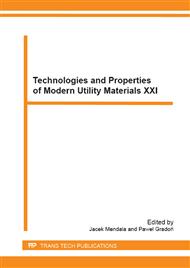p.179
p.183
p.187
p.191
p.195
p.201
p.205
p.211
p.215
Utilization of Metallurgical Waste in Non-Metallurgical Industry
Abstract:
The iron and steel industry is one of the largest sources of waste materials, primarily in the form of steelmaking dusts, sludge and slag. Those wastes are a serious threat to the environment. Main precondition for the protection of natural resources in the environment is to recover raw material and energy from waste. The use of waste as raw materials does not involve the storage and creates the possibility of closure of the existing landfill. The article presented utilization of same metallurgical waste containing 4-20 wt. % zinc in non-metallurgical industry. Performed chemical analyzes of pollutants contained in waste tested (dusts, sludge and slag) and in manufactured products (cement bricks, ceramic construction materials, colored glass products and slag for road construction). Aqueous extracts analysis results were compared with the maximum values for the sewage entering into water and soil. The performed research proves that proposed technologies (production of cement clinker, construction bricks, hollow glass, decorated glass) do not pose threat to environment. Harmful impurities are eluted from the products – clinker, constructions bricks and slag after the recovery of zinc recovery. Proposed technologies substitution of primary raw materials recyclable materials can reduce environmental degradation.
Info:
Periodical:
Pages:
195-200
Citation:
Online since:
December 2013
Authors:
Price:
Сopyright:
© 2014 Trans Tech Publications Ltd. All Rights Reserved
Share:
Citation:


